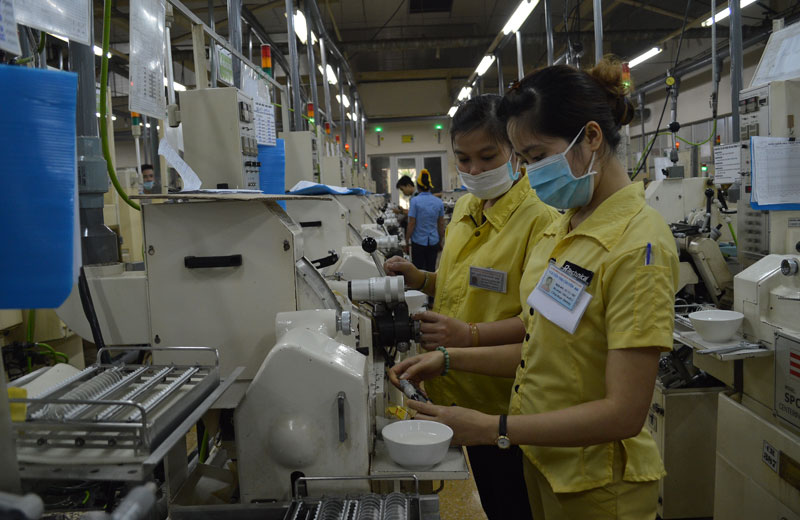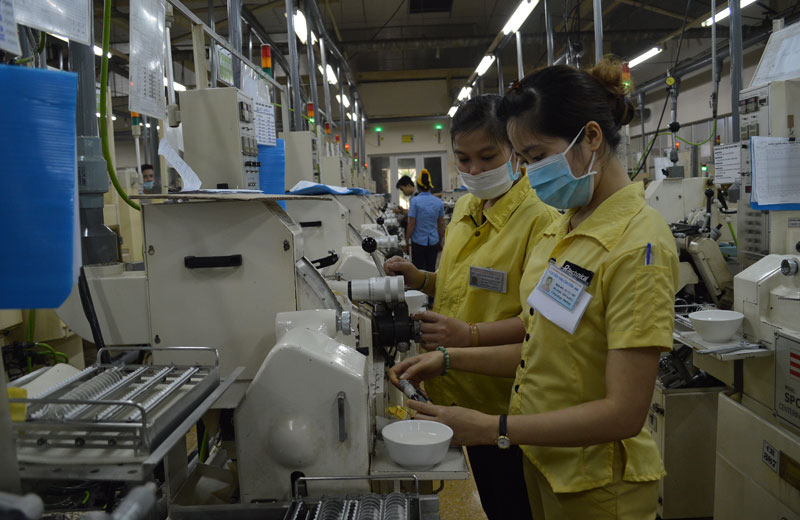
(HBO) – Hoa Binh province has invested much in industrial parks and clusters in recent years to attract more domestic and foreign investment. It is an important orientation in the province’s economic development strategy. Thanks to such effort, its industrial production reached more than 27.5 trillion VND (1.21 billion USD) last year, up 17.22 percent from the same period last year and 2.5 percent higher than the yearly target.
In the Da River Left-Bank Industrial Park,
more than 650 workers of the R Vietnam Technical Research Co., Ltd were still
busy making lens for export orders on the threshold of the New Year. Last year,
the company produced about 11 million product items and its export turnover reached
nearly 14.5 million USD, a year-on-year increase of 30 percent, despite
difficulties from fluctuations in the global economy.
Aside from the strong growth in export, the
firm has provided jobs for hundreds of locals and given them stable incomes
which averaged 6.5 million VND per person per month, said Nguyen Long, a
manager of the company.

Workers of the R Vietnam Technical Research
Co., Ltd in the Da River Left-Bank Industrial Park are making lens for export.
According the local authority’s report, the
province’s industrial production hit over 27.5 trillion VND in 2017, up 17.22
percent against the same period of the previous year. Its industrial production
index rose by 9.7 percent from 2016. Local industrial and handicraft firms remained
stable production with continued growth of key products, said the province’s
Department of Industry and Trade.
Some major products enjoyed strong growth like commercial electricity (8.01
percent), garment and textile (55.17 percent), brick (26.32 percent), cement
(22.45 percent), electronic products (26 percent), structural steel (18.92
percent), medium-density fibreboard (37.12 percent).
Also, export revenue experienced sound expansion thanks to local efforts to
diversify export markets while maintaining traditional ones like the US, the
EU, Russia, ASEAN, Japan, China and the Republic of Korea.
The province exported 505 million USD worth of products in 2017, a year-on-year
surge of 36.19 percent and 8.6 percent higher than the set plan. Meanwhile, it
spent more than 413.8 million USD on imports, up 28.8 percent from the previous
year and surpassing the set target by 5.57 percent.
A slew of measures have been deployed to effectively carry out the industrial
development project during 2016-2020 with vision towards 2030 to set up
large-scale production areas.
In July 2017, the provincial People’s Committee issued Plan No.91 on
implementing the industrial development project in 2016-2020 with vision
towards 2025. Accordingly, the province eyes an average growth of 10.5 percent
in added value of the industrial sector and a 15 percent growth in industrial
production value. Meanwhile, it expects that industry and construction will
make up 57.8 percent of its economy.
Infrastructure is key to develop local industry. The province will focus
investment on completing infrastructure in five industrial parks: Luong Son, Da
River Left-Bank, Mong Hoa, Lac Thinh and Yen Quang.
It will invest in developing basic infrastructure in six industrial clusters:
Chieng Chau, Khoang U, Phu Thanh II, Hoa Son, Dong Tam and Dong Lai-Thanh
Hoi./.
According to data from the Hoa Binh Provincial Party Committee, the industrial production index for the first six months of 2025 is estimated to have increased by 20% compared to the same period last year. This marks the highest year-on-year growth rate for this period since 2020.
In the first six months of 2025, Hoa Binh province’s export turnover was estimated at 1.145 billion USD, marking an 18.11% increase compared to the same period in 2024. Import turnover was estimated at $ 804 million, a 17.15% increase, which helped the province maintain a positive trade balance.
The lives of the ethnic minority farmers in Tan Lac district have gradually improved thanks to the new directions in agricultural production. This is a testament to the collective strength fostered through the professional associations and groups implemented by various levels of the district’s Farmers’ Union.
With the motto the "product quality comes first,” after nearly one year of establishment and operation, Muong village’s Clean Food Agricultural and Commercial Cooperative, located in Cau Hamlet, Hung Son Commune (Kim Boi district), has launched reputable, high-quality agricultural products to the market that are well-received by consumers. The products such as Muong village’s pork sausage, salt-cured chicken, and salt-cured pork hocks have gradually carved out a place in the market and they are on the path to obtaining the OCOP certification.
In the past, the phrase "bumper harvest, rock-bottom prices" was a familiar refrain for Vietnamese farmers engaged in fragmented, small-scale agriculture. But today, a new spirit is emerging across rural areas of Hoa Binh province - one of collaboration, organisation, and collective economic models that provide a stable foundation for production.
Maintaining growing area codes and packing facility codes in accordance with regulations is a mandatory requirement for agricultural products to be eligible for export. Recently, the Department of Agriculture and Environment of Hoa Binh province has intensified technical supervision of designated farming areas and packing facilities to safeguard the "green passport" that enables its products to access international markets.



